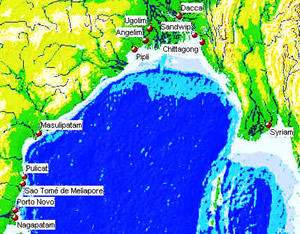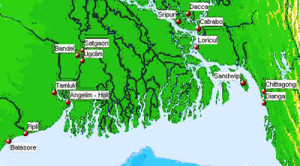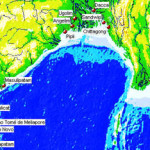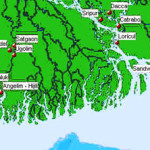Written by Marco Ramerini. English text revision by Dietrich Köster.
On the Bay of Bengal there was a rather peculiar form of Portuguese settlements. Indeed this coast was not conquered militarily like the Malabar coast, but was colonized pacifically by groups of “Casados” (married men of the reserve army), beginning in the 1520s.
SÃO TOMÉ DE MELIAPORE (Madras)
The main settlement was the town of São Tomé de Meliapore (near today’s Madras), where there was (and still is) the grave of the apostle Saint Thomas. In 1522-23 the Portuguese built a church there and, around it, a settlement was started. In 1523 a new city was born. In 1537 São Tomé was populated by 50 Casados. By 1544 their number had doubled. Then the Jesuits settled there in 1548/49. In spite of this fast development in the years between the foundation of São Tomé (1522) and in the 1560s the activity of the Portuguese was mainly concentrated on the settlement of Paleacate (Pulicat), founded in 1518, where in 1545 600-700 Portuguese Casados settled. In the relation of Cesare Federici (1560) the town of São Tomé was described as “la più bella di quante ne sono in quelle parti dell’India”.
In 1580 the town of São Tomé had four churches, those of São Tomé, São Francisco, São João Baptista and Misericórdia. Outside the town were the churches of Madre de Deus, São Lazaro, Nossa Senhora da Luz and Nossa Senhora do Monte. At the beginning of 1600 São Tomé had a population of about 600 Casados. On 9 January 1606 the Diocese of São Tomé de Meliapur was erected. In 1607 São Tomé was declared city and a “Câmara Municipal” was created. In 1614 the inhabitants erected fortifications and the whole population, i.e. the Portuguese administration, the “casados”, the soldiers and the native Christian population resided within the walled city. The city had a “capitão-mor” (captain-major) and a Bishop and in 1635 there were as many as 10 churches. In 1646 São Tomé was besieged by Mir Jumla of Qutbshahi.
The period between 1656 and 1662 is an obscure period and in 1662 São Tomé was conquered by Qutbshashi of Golconda. From 1662-1672 São Tomè remained in Qutbshahi hands. In 1672 the French under Admiral de la Haye conquered São Tomé, but after two years of occupation on 6 September 1674 the French surrendered the city to the Dutch, who, in turn, handed it over to the Qutbshahi on 10 October 1674. In 1687 a tenuous Portuguese administration was re-established. In January 1697 the fortification was pulled down; the only privilege that remained to the Portuguese residents in 1702 was to display their flag on Sundays and Holidays.
Portuguese influence came to an end on 21 October 1749, when the English (in principle Portugal’s allies) occupied São Tomé. Other Portuguese settlements were at Negapatam, Porto Novo, Masulipatam, Pulicat, Ugolim (near today’s Calcutta), Chittagong, Syriam (near today’s Rangoon), Dianga (in Arakan).
NAGAPATTINAM
The Portuguese colonized Nagapattinam at the same time as São Tomé (1520s-1530s). It was the best port of the entire Coromandel coast, ten villages (Nagappattinam Port, Puthur, Muttam, Poruvalancheri, Anthonippettai, Karureppankadu, Azhinji Mangalam, Sangamangalam, Thiruthina mangalam, Manjakollai, Nariyankudi) were controlled by the Portuguese traders. At the end of the 1540s the Franciscans and later the Jesuits settled in the town. Several churches were built in the city: Madre de Deus, São Jerónimo, Paulistas, São Domingos, Nossa Senhora da Nazaré, Sé. In 1577 there were in Nagapattinam 60 casados, 200 Eurasians, 3,000 Christian Indians. In the years 1642-43 Nagapattinam was fortified and a customs-house was also built. On 23 July 1658 a Dutch fleet under the command of Jan van der Laan conquered the fort. In the 1590s the Portuguese settled north of Nagapattinam in a port, they named Porto Novo (New Harbour), this port was the place, where the Portuguese moved in after the Dutch conquest of Nagapattinam.
NORTHERN PART OF THE BAY OF BENGAL
The first Portuguese expedition in Bengal landed in Chittagong in 1517. This port was the most important of all; the Portuguese called it “Porto Grande” (Large Harbour). After this first visit the Portuguese sent to Bengal a ship with merchandise annually. In 1536-37 the King of Bengal gave the customs-house of Chittagong (Porto Grande) and Satgaon (Porto Pequeno) to the Portuguese and also permitted to build “feitorias” (trading posts) in both towns.
PIPLI (Orissa)
The first settlement in the Gulf of Bengal was established in Orissa, at Pipli, by some Portuguese, who had escaped from São Tomé in 1514. Pipli was an important trading center and the Augustinians had built a church and a residence. At the beginning of the XVIIIth century a large Portuguese and Eurasian community populated Pipli.
UGOLIM, SATGAON, BANDEL
The destiny of the first settlement in Satgaon is obscure. But in 1579-80 António Tavares founded Ugolim (Hooghly) at the mouth of the Ganges near the first settlement of Satgaon. The town grew rapidly. The religious orders erected many churches and in 1603 it had about 5,000 Portuguese inhabitants. Satgaon was again under the authority of the Portuguese from the 1590s, but Ugolim outshined this settlement. A few kilometers further north was the community of Bandel, where the Order of the Augustinians built a friary in 1599, to which the Church of Nossa Senhora do Rosário was attached (this church still exists in Bandel, although it was rebuilt in 1660, after its destruction during the sacking of Hooghly by the Moors in 1632). The Portuguese of Ugolim extended their settlements sixty leagues inland from the banks of the river. Since the beginning of the XVIIth century they had the Bengali trade in their hands. In Ugolim the religious orders erected many churches, a hospital, a Casa da Misericórdia (Institution of charity) and a school. The Portuguese never fortified Ugolim and when the Mughals besieged the city it had only an earthen parapet. The siege began on 24 June 1632 and the Portuguese defenders were only three hundred and about six hundred native Christians. The defenders held out for three months, but on 25 September 1632 the Mughals launched a violent attack and captured the town. The Portuguese lost about 3,000-5,000 men, the civil population included. On the Mughals’ side the losses were enormous. There were only three thousand Portuguese survivors. They escaped to Saugor island, where they built a fortress. By July 1633, only a year after the siege of Ugolim, the Portuguese settled again in Ugolim (The Shah Jahan conceded to them a grant of land there). The motive of their return remains unexplained. Notwithstanding this move, the Portuguese never regained their past power. In 1666 a witness reported that at Ugolim there were about 8,000 to 9,000 Portuguese and Eurasians and the Augustinians and the Jesuits possessed large churches. In 1680 in all Bengal there were not less than 20,000 Portuguese Mestiços (people of mixed blood).
CHITTAGONG (CHATIGAM), DIANGA, SANDWIP
The settlement of Chittagong (Chatigam) grew into a great trading center. The Jesuits erected two churches and a residence. About 1590 the Portuguese also captured the fort of Chittagong and made the island of Sandwip a tributary. In 1598 there were 2,500 Portuguese and Eurasians in Chittagong and Arakan. In 1602 Sandwip was conquered by Domingo Carvalho and Manuel de Mattos. This island was, however, lost a short time later (1605 ?).
Towards the end of the XVIth century, the Portuguese also settled in Dianga (today’s Bunder or Feringhi Bunder), opposite to Chittagong across the southern bank of the Karnaphuli River. In 1607 the King of Arakan massacred about 600 Portuguese inhabitants of Dianga. The Portuguese settled again in Dianga after 1615. Despite the Dianga massacre a small number of Portuguese managed to escape and settled on an island at the mouth of the Ganges.
One of them was Sebastião Gonçalves Tibau, who later in 1607 (?), leading 400 Portuguese, attacked and conquered the island of Sandwip for the second time. He ruled the island like an independent king, having under his command a force of 1,000 Portuguese. Tibau also seized the islands of Dakhin Shahbazpur and Patelbanga. In 1615 Tibau proceeded to conquer Arakan and asked for help from Goa, which promptly came. On October 1615 the Portuguese fleet attacked the Arakanese fleet, which was reinforced by a Dutch fleet. They won the battle and the majority of the Portuguese Navy returned to Goa. Soon after in 1616 Sebastião Gonçalves Tibau was defeated by the King of Arakan, who invaded Sandwip and took possession of the island.
After Tibau’s defeat the Portuguese in Eastern Bengal (out of the control of Goa) devoted themselves to piracy. They allied with the King of Arakan and settled in Dianga and Chittagong. They allied with the King of Arakan and settled in Dianga and Chittagong. When the Mughals took Chittagong in 1665, they moved to Ferenghi Bazar (South of today’s Dacca), where Portuguese descendents still reside to the present day.
MINOR SETTLEMENTS IN BENGAL
The Portuguese settled at Dacca about 1580. The remains of the Portuguese trading factory, close to the church of Our Ladies of Rosary, were still evident in 1919 . Other small Portuguese settlements thrived in Bengal: At the end of the XVIth century in Sripur, Chandecan, Bakla, Catrabo, Loricul (where at the end of the XVIIIth century the ruins of a Portuguese church were still evident) and Bhulua, where at the end of the XVIIth century many people spoke Portuguese. In the 1520s some Portuguese settled in Hijili (Hidgelee or Angelim). Here they possessed a large tract of land. The Augustinians built two churches in Hijili. Hijili was lost in 1636. In 1919 the ruins of the Portuguese settlement were still visible. In 1838 at Merepore (three kms south of Hijili) a community of Christians, who claimed to be descendents of the Portuguese from Goa, was found. At Tamluk (Tambolim) was built a church in 1635 and as late as in 1724 the Portuguese had churches and traded there. At Balasore there were small Portuguese settlements. In 1880 a small chapel was still standing. It has disappeared by now.
SYRIAM (Myanmar-Burma)
In the year 1602 the King of Arakan granted the port of Syriam (today’s Rangoon) in Pegu to Felipe de Brito e Nicote for his services. There the Portuguese built a fort and a customs-house. Syriam remained in the hands of the Portuguese untill 1613 when the King of Ava captured it. The Portuguese settlements on the Bay of Bengal reached their apogee in the first decade of the XVIIth century.
- Portuguese settlements in the bay of Bengal. Author Marco Ramerini
- Map of the Portuguese settlements in North Bengal Bay. Author Marco Ramerini
BIBLIOGRAPHY:
– Various Authors “Commerce and Culture in the Bay of Bengal, 1500-1800” 416 p. plates, edited by Om Prakash and Denys Lombard, 1999,
– Arasaratnam, S. and Aniruddha, R. “Masulipatnam and Cambay: a history of two port towns, 1500-1800” xiii, 314pp. maps Munshiram Manoharlal, 1994, New Delhi, India.
– Banerji, Chitrita “How Bengal Discovered Chhana” Portuguese influences in Bengala food.
– Campos, J. J. A. “History of the Portuguese in Bengal” 283 pp. 3 maps Butterworth & Co. 1919 Calcutta, India. An old, but very interesting, book about the Portuguese history in Bengal, history unknown to many people.
– Cortesão , Armando ” A cidade de Bengala do século XVI e os Portugueses” 35 pp. Tip. da Sociedade Astória, 1944, Lisboa
– Ferroli, D. “The jesuits and Mysore” 238 pp. Xavier Press, 1955, Kozhikode, India.
– Jeyaseela, Stephen S. “Portuguese on the Tamil Coast : Historical Explorations in Commerce and Culture, 1507-1749” xix + 437 pp. Illus., Maps, Navajothi Publishing House, 1998, Pondicherry, India.
– Jeyaseela Stephen S. “Coromandel Coast and its Hinterland: Economy, Society And Political System, 1500-1600” 269 pp. Manohar Publishers & Distributors, 1997, Delhi, India.
– Mordechai, Arbell “The Portuguese Jewish community of Madras, India, in the Seventeenth century” In: “Los Muestros. The Sephardic Voice” n° 41, Dec. 2000
– Subrahmanyam, Sanjay “Comércio e conflito: a presenca portuguesa no Golfo de Bengala” Orig. Tit. “Improvising empire Portuguese trade and settlement in the Bay of Bengal 1500-1700” 293 pp Edições 70 1994 Lisboa. A collection of very interesting articles of Subrahmanyam.
– Subrahmanyam, Sanjay “The South Coromandel Portuguese in the late 17th century: a study of the Porto Novo. Nagapattinam complex” In STUDIA N° 49, pp. 341-363, 1989, Lisbon, Portugal.
– Varadarajan, L. “São Tomé: early European activities and aspirations” In: Various Authors “II Seminário Internacional de História Indo–Portuguesa” 429-441 pp. IICT & CEHCA 1985 Lisbon, Portugal.
 Colonial Voyage The website dedicated to the Colonial History
Colonial Voyage The website dedicated to the Colonial History







































































